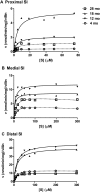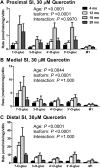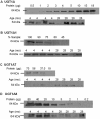Microsomal quercetin glucuronidation in rat small intestine depends on age and segment
- PMID: 21543555
- PMCID: PMC3141883
- DOI: 10.1124/dmd.111.038406
Microsomal quercetin glucuronidation in rat small intestine depends on age and segment
Abstract
UDP-glucuronosyltransferase (UGT) activity toward the flavonoid quercetin and UGT protein were characterized in three equidistant small intestine (SI) segments from 4-, 12-, 18-, and 28-month-old male Fischer 344 rats (n = 8/age) using villin to control for enterocyte content. SI microsomal intrinsic clearance of quercetin was increased 3- to 9-fold from 4 months in the proximal and distal SI at 12 and 18 months. Likewise, at 30 μM quercetin, SI microsomal glucuronidation activity was increased with age: 4.8- and 3.9-fold greater at 18 months than at 4 months. Quercetin UGT regioselectivity was not changed by age. The distal SI preferentially catalyzed glucuronidation at the 7-position, whereas the proximal SI produced the greatest proportion of 4'- and 3'-conjugates. Enterocyte UGT content in different SI segments was not consistently changed with age. In the proximal SI, UGT1A increased 64 and 150% at 12 and 18 months and UGT1A1, UGT1A7, and UGT1A8 were also increased at 12 and 18 months. However, age-related changes in expression were inconsistent in the medial and distal segments. Microsomal rates of quercetin glucuronidation and UGT expression were positively correlated with UGT1A1 content for all pooled samples (r = 0.467) and at each age (r = 0.538-0.598). UGT1A7 was positively correlated with total, 7-O- and 3-O-quercetin glucuronidation at 18 months. Thus, age-related differences in UGT quercetin glucuronidation depend on intestinal segment, are more pronounced in the proximal and distal segments and may be partially related to UGT1A1 and UGT1A7 content.
Figures







Similar articles
-
Troglitazone glucuronidation in human liver and intestine microsomes: high catalytic activity of UGT1A8 and UGT1A10.Drug Metab Dispos. 2002 Dec;30(12):1462-9. doi: 10.1124/dmd.30.12.1462. Drug Metab Dispos. 2002. PMID: 12433820
-
Characterization of rat intestinal microsomal UDP-glucuronosyltransferase activity toward mycophenolic acid.Drug Metab Dispos. 2006 Sep;34(9):1632-9. doi: 10.1124/dmd.106.010140. Epub 2006 Jun 21. Drug Metab Dispos. 2006. PMID: 16790558
-
Regioselectivity of phase II metabolism of luteolin and quercetin by UDP-glucuronosyl transferases.Chem Res Toxicol. 2002 May;15(5):662-70. doi: 10.1021/tx0101705. Chem Res Toxicol. 2002. PMID: 12018987
-
Glucuronidation of tizoxanide, an active metabolite of nitazoxanide, in liver and small intestine: Species differences in humans, monkeys, dogs, rats, and mice and responsible UDP-glucuronosyltransferase isoforms in humans.Comp Biochem Physiol C Toxicol Pharmacol. 2024 Sep;283:109962. doi: 10.1016/j.cbpc.2024.109962. Epub 2024 Jun 16. Comp Biochem Physiol C Toxicol Pharmacol. 2024. PMID: 38889874
-
Disposition of flavonoids via enteric recycling: enzyme stability affects characterization of prunetin glucuronidation across species, organs, and UGT isoforms.Mol Pharm. 2007 Nov-Dec;4(6):883-94. doi: 10.1021/mp700135a. Mol Pharm. 2007. PMID: 18052087 Free PMC article.
Cited by
-
Inhibitory effects of quercetin and its major metabolite quercetin-3-O-β-D-glucoside on human UDP-glucuronosyltransferase 1A isoforms by liquid chromatography-tandem mass spectrometry.Exp Ther Med. 2021 Aug;22(2):842. doi: 10.3892/etm.2021.10274. Epub 2021 Jun 6. Exp Ther Med. 2021. PMID: 34149888 Free PMC article.
-
Plasma quercetin metabolites are affected by intestinal microbiota of human microbiota-associated mice fed with a quercetin-containing diet.J Clin Biochem Nutr. 2019 Nov;65(3):232-239. doi: 10.3164/jcbn.19-45. Epub 2019 Oct 10. J Clin Biochem Nutr. 2019. PMID: 31777425 Free PMC article.
-
Glucuronidation as a metabolic barrier against zearalenone in rat everted intestine.J Vet Med Sci. 2020 Feb 4;82(2):153-161. doi: 10.1292/jvms.19-0570. Epub 2019 Dec 16. J Vet Med Sci. 2020. PMID: 31839622 Free PMC article.
-
Hepatoenteric recycling is a new disposition mechanism for orally administered phenolic drugs and phytochemicals in rats.Elife. 2021 Jul 1;10:e58820. doi: 10.7554/eLife.58820. Elife. 2021. PMID: 34196607 Free PMC article.
References
-
- Basu NK, Ciotti M, Hwang MS, Kole L, Mitra PS, Cho JW, Owens IS. (2004) Differential and special properties of the major human UGT1-encoded gastrointestinal UDP-glucuronosyltransferases enhance potential to control chemical uptake. J Biol Chem 279:1429–1441 - PubMed
-
- Bischoff SC. (2008) Quercetin: potentials in the prevention and therapy of disease. Curr Opin Clin Nutr Metab Care 11:733–740 - PubMed
-
- Boersma MG, van der Woude H, Bogaards J, Boeren S, Vervoort J, Cnubben NH, van Iersel ML, van Bladeren PJ, Rietjens IM. (2002) Regioselectivity of phase II metabolism of luteolin and quercetin by UDP-glucuronosyl transferases. Chem Res Toxicol 15:662–670 - PubMed
Publication types
MeSH terms
Substances
Grants and funding
LinkOut - more resources
Full Text Sources
Medical
Molecular Biology Databases

